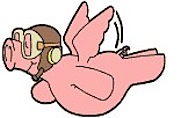
Ho, ho, ho. Merry Christmas.
Or something like that.
Thanks to a wickedly strange website entitled Sketchy Santas for today’s visual. If you have a warped sense of humor like I do, go on over and take a peek. I’ll use a couple more of them here before we say goodbye to the Christmas season. I mean, after all, a little warped sense of humor is good for us all this time of year — yes?
Speaking of this time of year — it’s the time of the year when those folks who run the airlines start talking. To analysts. About their respective fourth quarter results that will be finalized in a little more than two weeks.
Today Bill Greene with Morgan Stanley wrote,
“We expect near-term data points and commentary to excite investors about the on-going airline recovery, pushing potential concerns of an anemic 2010 to the background, for the time being.”
Oh my. Let’s pop some champagne corks. What do you think?
Bill went on to talk more specifically as he added that AMR now expects fourth quarter mainline PRASM to be down more or less 5% year-over-year. This is better than Bill’s previous 7% estimate. The airline also said this week that close-in bookings continue to be strong.
US Airways said this week that it continues to see revenue improving “rapidly.” The airline said this week that corporate revenues could be up by as much as 10% year-over-year in 2010. Delta expects strong demand trends in 2010 and fourth quarter guidance updates imply better than expected top-line growth and United Airlines aid this week that it also continues to see improvement in corporate and premium cabin bookings.
Yesterday analysts Jamie Baker and Mark Streeter with JP Morgan issued a note in which they talked about both stock and debt updates.
They also talked about the positive comments from Delta and US Airways as did Bill. JP Morgan lifted its fourth quarter estimates for both Delta Air Lines and US Airways based on the latest updates from both carriers.
On the debt side, Mark Streeter gave all of us some good background on the fact that Delta Air Lines did also offer year-end liquidity estimates that were lower than those previously distributed this week.
Is this a bad thing? Not according to Mark.
According to Mark,
“Delta offered year-end liquidity guidance of $5.1 billion (versus our prior estimate for YE09 of $5.4 billion), or about $700 million lower than the $5.8 billion total liquidity as of 30-Sept-09. Given a seasonal air traffic liability shift of $800 million-$1 billion (per management), the net burn is deceiving. As we have discussed, Delta has reduced 2010 debt maturities by 55% from $3.4 billion prior to recent capital markets transactions (mainly secured first and second lien notes and a secured aircraft EETC deal) to $1.5 billion.
In our Airline Credit Outlook 2010 webcast, we reiterate our bullish view on airline credit (Overweight) and our specific opinion that Delta is our favorite legacy airline credit from a relative value perspective. We recommend Delta A (offered at 400bp+) and B tranche (9%+ yield) EETCs basically across the board (As for HG and HY investors, Bs for HY investors only) as well as the Delta first (9.5% bonds yielding 8.5%) and second lien (12.25% bonds yielding 13%) backed by Delta’s Pacific operations. On the situation in Japan, AMR has the most to lose and Delta the most to gain if JAL defects from OneWorld to SkyTeam.
On the other hand, US-Japan Open Skies remains a long-term wild card from the perspective of how appraisers and the market will value Delta’s Pacific collateral. Regardless, we expect Delta to maintain a large, significant presence in Asia and Narita specifically (and perhaps Haneda over time). Therefore, the short relative duration of the 9.5%s (due Sep-14) and the 12.25%s (due Mar-15) coupled with high current yields relative to credit ratings (credit ratings that should INCREASE over time given our forecasted improvement in Delta’s credit metrics against our bullish industry recovery thesis) forms the basis of our favorable opinion on these unique bonds.”
Yes, that man is still bullish on Delta Debt.









